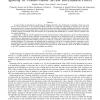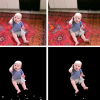514 search results - page 6 / 103 » Sparse appearance based modeling for robot localization |
RAS
2000
13 years 7 months ago
2000
We address the problem of visual-based navigation of a mobile robot in indoors environments. The robot control system is based on a single camera to provide the required visual fe...
ISRR
2005
Springer
14 years 1 months ago
2005
Springer
An open problem in Simultaneous Localization and Mapping (SLAM) is the development of algorithms which scale with the size of the environment. A few promising methods exploit the ...
CVPR
2009
IEEE
15 years 2 months ago
2009
IEEE
This paper presents an algorithm for automatically detecting and segmenting a moving object from a monocular video. Detecting and segmenting a moving object from a video with limit...
ROBOCUP
2000
Springer
13 years 11 months ago
2000
Springer
Self localization seems necessary for mobile robot navigation. The conventional method such as geometric reconstruction from landmark observations is generally time-consuming and ...
ECCV
2010
Springer
13 years 12 months ago
2010
Springer
Sparse coding of sensory data has recently attracted notable attention in research of learning useful features from the unlabeled data. Empirical studies show that mapping the data...


